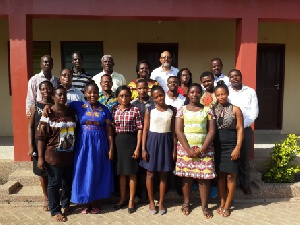 The writer with some teacher at Prampram
The writer with some teacher at Prampram
Whether teaching is an art or a science continues to be a debate and was a popular cerebral sport during my youth in the school of education. On one hand, if teaching calls for the soft intrinsic behaviours such as motivation, inspiration, values, perseverance, intuition, talent, creativity, etc – then it is an art.
On the other hand, it is a science when teaching requires, one, knowledge of a subject matter which in itself involved a period of systematic study under expert guidance, and two, if it requires the skills to deliver one’s knowledge through applying the proper principles to suit the needs of each person or class.
Teaching is a complex matter
Teaching is a complex matter: one has to know much about the particular subject, the students, and the processes of pedagogy. In the artistic part, one has to have nurtured a certain flair for engaging with people. One has to have the ability to create new methods, new ways of imparting knowledge. Whatever moves there are, they have to consistently add value to one’s repertoire of instruction delivery by advancing the practice.
Studying how people learn is only half of the equation; the other half is knowing how to teach them. Quality teachers do both, even as they continue to learn from their successes and mistakes, knowing that no two people or classes are ever the same. What works for one brilliantly may fall flat with another. These are the waters in which teachers swim.
In my own experience, after a first degree from the school of business, the licensed teaching credential itself took another four years. That period entailed teaching full time in the day, and schooling at night and weekends taking courses in the psychology of teaching, methodology, and various other courses in subject area – English.
Why doesn’t the sun fall?
The Swiss educator, Jean Piaget (1896 – 1980), used experimental psychology in the methodology he used to understand how the minds of children work. He used particular questions in the course of his clinical investigations to elicit children’s responses. He would, for example, ask a five-year old child, “Why doesn’t the sun fall?”
Clearly, in his approach, he knew that the child had neither the kind of ready answer one would expect from years of careful thought and practice, nor the child’s capacity to generate measurable scientific responses on their own. But Piaget’s concern wasn’t for a right answer per se: he was merely exploring how children think without formal education, without following the dictates of some specific pedagogy. The questions merely served to induce some understanding of how children form their views or use their imagination within the confines of their small world. That notion often reminds me of the Akan adage, “Obiara nkyere akodaa Nyame”, [to wit, children know God without having been taught].
Piaget employed curious questions that went far beyond the reach of any child’s intellectual ability but he used them as catalysts to discern how children think in pure, unadulterated form, entirely independent of formal learning.
Experimenting with Piaget’s method
Before the advent of the now popular cliché, “Think outside the box”, children were already outside the box in their outlook of the world. When a child’s attention is drawn to even a static object, they naturally respond by bringing into the open a new bit of unrehearsed, unexpected understanding.
In trying to emulate Piaget as a new teacher, I devised questions I thought Piaget would ask. One was this: “Why do people fight?” Without so much as a fraction of a thought, the child I asked responded, “Because they want to be friends.” To have pressed the child further to explain the answer might have revealed some psychodynamics with the potential to enthrall Sigmund Freud (1856 – 1939), the so-called father of psychotherapy.
Give children an impossible question, and they will give you back a possible answer. And that brings me to a conversation I once had with Eleanor Duckworth of Harvard Graduate School of Education (HGSE), at her office at Longfellow, Cambridge. She was a Piaget protégé having studied under him in her youth. She said, “Getting people to think about what they think, and asking them questions about it, is the best way I know how to teach.” She was to add, “You don’t want to cover a subject; you want to uncover it.”
How to keep improving
In Japan, when a bowl or a ceramic art falls and breaks, the pieces are picked up, and put together again. The cracks are re-sealed with gold which create a beautiful mosaic of the original piece, to emphasise the beauty in what was once broken. They believe that when something has suffered damage and has a history, it makes it more beautiful, and the same goes for human beings. Everything that you’ve gone through or are going through doesn’t make your life any uglier though it may seem that way when you’re going through it. Hardly does anything break beyond repair.
To the Japanese, then, whenever one complains it simply means that the person hasn’t learned from what happened or that the experience wasn’t useful. Amend the cracks in one’s life with pieces of gold, and turn into a better person for a better life.
Education is a journey, not a destination; and it calls for continuous training. Raising people to have successful lives – and thereby have them contribute to the larger society – is a most sacred responsibility.
Email: anishaffar@gmail.com